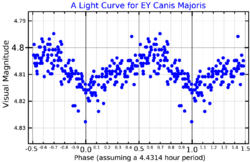Astronomy:15 Canis Majoris
| Observation data Equinox J2000.0]] (ICRS) | |
|---|---|
| Constellation | Canis Major |
| Right ascension | 06h 53m 32.907s[2] |
| Declination | −20° 13′ 27.32″[2] |
| Apparent magnitude (V) | +4.82[3] |
| Characteristics | |
| Spectral type | B1 Ib[4] |
| U−B color index | -0.96[5] |
| B−V color index | −0.212±0.013[3] |
| Variable type | β Cep[4][6] |
| Astrometry | |
| Radial velocity (Rv) | 28.00[7] km/s |
| Proper motion (μ) | RA: −5.46±0.16[2] mas/yr Dec.: +3.58±0.17[2] mas/yr |
| Parallax (π) | 2.68 ± 0.24[2] mas |
| Distance | 1,200 ± 100 ly (370 ± 30 pc) |
| Absolute magnitude (MV) | −3.02[3] |
| Details[4] | |
| Mass | 12.8±1.2 M☉ |
| Radius | 6.8±1.2 R☉ |
| Luminosity | 20,000+12,000 −7,400 L☉ |
| Surface gravity (log g) | 3.89±0.20 cgs |
| Temperature | 26,100±1,200 K |
| Rotational velocity (v sin i) | 20±12 km/s |
| Other designations | |
| Database references | |
| SIMBAD | data |
15 Canis Majoris is a variable star in the southern constellation of Canis Major,[8] located roughly 1,200 light years away from the Sun.[2] It has the variable star designation EY Canis Majoris; 15 Canis Majoris is the Flamsteed designation. The star is visible to the naked eye as a faint, blue-white hued star with a baseline apparent visual magnitude of +4.82.[3] It is moving away from the Earth with a heliocentric radial velocity of 28 km/s.[7]
This is a B-type supergiant star with a stellar classification of B1 Ib.[4] It is classified as a Beta Cephei type variable star and its brightness varies from magnitude +4.79 down to +4.84 with a period of 4.430 h.[6] The star has 12.8 times the mass of the Sun and 6.8 times the Sun's radius. It is radiating 20,000 times the luminosity of the Sun from its photosphere at an effective temperature of 26,100 K.[4]
References
- ↑ Heynderickx, D. (December 1992). "A photometric study of beta Cephei stars. I. Frequency analyses". Astronomy & Astrophysics Supplement Series 96: 207–254. Bibcode: 1992A&AS...96..207H. https://ui.adsabs.harvard.edu/abs/1992A&AS...96..207H. Retrieved 14 November 2021.
- ↑ Jump up to: 2.0 2.1 2.2 2.3 2.4 2.5 van Leeuwen, F. (2007). "Validation of the new Hipparcos reduction". Astronomy and Astrophysics 474 (2): 653–664. doi:10.1051/0004-6361:20078357. Bibcode: 2007A&A...474..653V. Archived from the original on 2016-04-02. https://web.archive.org/web/20160402233353/http://www.aanda.org/index.php?option=com_article&access=bibcode&Itemid=129&bibcode=2007A&A...474..653VFUL. Vizier catalog entry
- ↑ Jump up to: 3.0 3.1 3.2 3.3 Anderson, E.; Francis, Ch. (2012), "XHIP: An extended hipparcos compilation", Astronomy Letters 38 (5): 331, doi:10.1134/S1063773712050015, Bibcode: 2012AstL...38..331A.
- ↑ Jump up to: 4.0 4.1 4.2 4.3 4.4 Hubrig, S. et al. (January 2009), "New magnetic field measurements of beta Cephei stars and Slowly Pulsating B stars", Astronomische Nachrichten 330 (4): 317, doi:10.1002/asna.200811187, Bibcode: 2009AN....330..317H
- ↑ Mermilliod, J.-C. (1986). "Compilation of Eggen's UBV data, transformed to UBV (unpublished)". Catalogue of Eggen's UBV Data. Bibcode: 1986EgUBV........0M.
- ↑ Jump up to: 6.0 6.1 Samus, N. N. et al. (2017), "General Catalogue of Variable Stars", Astronomy Reports, 5.1 61 (1): 80–88, doi:10.1134/S1063772917010085, Bibcode: 2017ARep...61...80S.
- ↑ Jump up to: 7.0 7.1 Gontcharov, G. A. (2006). "Pulkovo Compilation of Radial Velocities for 35 495 Hipparcos stars in a common system". Astronomy Letters 32 (11): 759–771. doi:10.1134/S1063773706110065. Bibcode: 2006AstL...32..759G.
- ↑ Jump up to: 8.0 8.1 "15 CMa". SIMBAD. Centre de données astronomiques de Strasbourg. http://simbad.u-strasbg.fr/simbad/sim-basic?Ident=15+CMa.
 |


